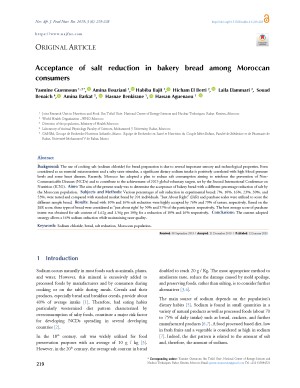Acceptance of salt reduction in bakery bread among Moroccan consumers
Abstract
Background: The use of cooking salt (sodium chloride) for bread preparation is due to several essential sensory and technological properties. Even considered as an essential micronutrient and a salty taste stimulus, a significant dietary sodium intake is positively correlated with high blood pressure levels and some heart diseases. Recently, Morocco has adopted a plan to reduce salt consumption aiming to reinforce the prevention of Non-Communicable Diseases (NCDs) and to contribute to the achievement of 2025 global voluntary targets, set by the Second International Conference on Nutrition (ICN2). Aims: The aim of the present study was to determine the acceptance of bakery bread with a different percentage reduction of salt by the Moroccan population. Subjects an Methods: Various percentages of salt reduction in experimental bread; 7%, 10%, 16%, 23%, 30%, and 53%, were tasted and compared with standard market bread by 201 individuals. “Just About Right” (JAR) and purchase scales were used to score the different bread. Results: Bread with 10% and 16% salt reduction were highly accepted by 76% and 79% of tasters, respectively. Based on the JAR score, these types of bread were considered as “just about right’ by 50% and 57% respectively by the participants. The best average score of purchase intent was obtained for salt content of 1.62g and 1.56g per 100g for a reduction of 10% and 16% respectively. Conclusions: The current adopted strategy allows a 16% sodium reduction while maintaining taste quality.
Full text article
Authors
Copyright (c) 2020 Authors

This work is licensed under a Creative Commons Attribution 4.0 International License.
-
Attribution — You must give appropriate credit, provide a link to the license, and indicate if changes were made. You may do so in any reasonable manner, but not in any way that suggests the licensor endorses you or your use.
-
No additional restrictions — You may not apply legal terms or technological measures that legally restrict others from doing anything the license permits.





